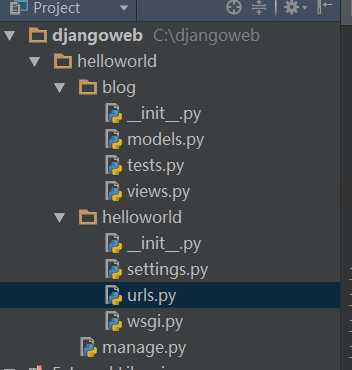标签:

如上为项目结构
1、创建项目helloworld
2、把目录切换到django/helloworld目录下创建blog站点
3、需要修改的信息如下:
1)修改blog站点的views.py
# Create your views here. #coding:utf-8 from django.http import HttpResponse def index(request): return HttpResponse("hello,Django")
2)修改setting.py文件
# Django settings for helloworld project. DEBUG = True TEMPLATE_DEBUG = DEBUG ADMINS = ( # (‘Your Name‘, ‘your_email@example.com‘), ) MANAGERS = ADMINS DATABASES = { ‘default‘: { ‘ENGINE‘: ‘django.db.backends.‘, # Add ‘postgresql_psycopg2‘, ‘mysql‘, ‘sqlite3‘ or ‘oracle‘. ‘NAME‘: ‘‘, # Or path to database file if using sqlite3. # The following settings are not used with sqlite3: ‘USER‘: ‘‘, ‘PASSWORD‘: ‘‘, ‘HOST‘: ‘‘, # Empty for localhost through domain sockets or ‘127.0.0.1‘ for localhost through TCP. ‘PORT‘: ‘‘, # Set to empty string for default. } } # Hosts/domain names that are valid for this site; required if DEBUG is False # See https://docs.djangoproject.com/en/1.5/ref/settings/#allowed-hosts ALLOWED_HOSTS = [] # Local time zone for this installation. Choices can be found here: # http://en.wikipedia.org/wiki/List_of_tz_zones_by_name # although not all choices may be available on all operating systems. # In a Windows environment this must be set to your system time zone. TIME_ZONE = ‘Asia/Shanghai‘ # Language code for this installation. All choices can be found here: # http://www.i18nguy.com/unicode/language-identifiers.html LANGUAGE_CODE = ‘zh-cn‘ SITE_ID = 1 # If you set this to False, Django will make some optimizations so as not # to load the internationalization machinery. USE_I18N = True # If you set this to False, Django will not format dates, numbers and # calendars according to the current locale. USE_L10N = True # If you set this to False, Django will not use timezone-aware datetimes. USE_TZ = True # Absolute filesystem path to the directory that will hold user-uploaded files. # Example: "/var/www/example.com/media/" MEDIA_ROOT = ‘‘ # URL that handles the media served from MEDIA_ROOT. Make sure to use a # trailing slash. # Examples: "http://example.com/media/", "http://media.example.com/" MEDIA_URL = ‘‘ # Absolute path to the directory static files should be collected to. # Don‘t put anything in this directory yourself; store your static files # in apps‘ "static/" subdirectories and in STATICFILES_DIRS. # Example: "/var/www/example.com/static/" STATIC_ROOT = ‘‘ # URL prefix for static files. # Example: "http://example.com/static/", "http://static.example.com/" STATIC_URL = ‘/static/‘ # Additional locations of static files STATICFILES_DIRS = ( # Put strings here, like "/home/html/static" or "C:/www/django/static". # Always use forward slashes, even on Windows. # Don‘t forget to use absolute paths, not relative paths. ) # List of finder classes that know how to find static files in # various locations. STATICFILES_FINDERS = ( ‘django.contrib.staticfiles.finders.FileSystemFinder‘, ‘django.contrib.staticfiles.finders.AppDirectoriesFinder‘, # ‘django.contrib.staticfiles.finders.DefaultStorageFinder‘, ) # Make this unique, and don‘t share it with anybody. SECRET_KEY = ‘q-$_k0g=jx3!n-#a&ul@if1rpd5_rc_l)j3pw4x84hd=hma_@+‘ # List of callables that know how to import templates from various sources. TEMPLATE_LOADERS = ( ‘django.template.loaders.filesystem.Loader‘, ‘django.template.loaders.app_directories.Loader‘, # ‘django.template.loaders.eggs.Loader‘, ) MIDDLEWARE_CLASSES = ( ‘django.middleware.common.CommonMiddleware‘, ‘django.contrib.sessions.middleware.SessionMiddleware‘, ‘django.middleware.csrf.CsrfViewMiddleware‘, ‘django.contrib.auth.middleware.AuthenticationMiddleware‘, ‘django.contrib.messages.middleware.MessageMiddleware‘, # Uncomment the next line for simple clickjacking protection: # ‘django.middleware.clickjacking.XFrameOptionsMiddleware‘, ) ROOT_URLCONF = ‘helloworld.urls‘ # Python dotted path to the WSGI application used by Django‘s runserver. WSGI_APPLICATION = ‘helloworld.wsgi.application‘ TEMPLATE_DIRS = ( # Put strings here, like "/home/html/django_templates" or "C:/www/django/templates". # Always use forward slashes, even on Windows. # Don‘t forget to use absolute paths, not relative paths. ) INSTALLED_APPS = ( ‘django.contrib.auth‘, ‘django.contrib.contenttypes‘, ‘django.contrib.sessions‘, ‘django.contrib.sites‘, ‘django.contrib.messages‘, ‘django.contrib.staticfiles‘, # Uncomment the next line to enable the admin: # ‘django.contrib.admin‘, # Uncomment the next line to enable admin documentation: # ‘django.contrib.admindocs‘, ‘blog‘, ) SESSION_SERIALIZER = ‘django.contrib.sessions.serializers.JSONSerializer‘ # A sample logging configuration. The only tangible logging # performed by this configuration is to send an email to # the site admins on every HTTP 500 error when DEBUG=False. # See http://docs.djangoproject.com/en/dev/topics/logging for # more details on how to customize your logging configuration. LOGGING = { ‘version‘: 1, ‘disable_existing_loggers‘: False, ‘filters‘: { ‘require_debug_false‘: { ‘()‘: ‘django.utils.log.RequireDebugFalse‘ } }, ‘handlers‘: { ‘mail_admins‘: { ‘level‘: ‘ERROR‘, ‘filters‘: [‘require_debug_false‘], ‘class‘: ‘django.utils.log.AdminEmailHandler‘ } }, ‘loggers‘: { ‘django.request‘: { ‘handlers‘: [‘mail_admins‘], ‘level‘: ‘ERROR‘, ‘propagate‘: True, }, } }
3)修改urls.py文件
from django.conf.urls import patterns, include, url #注意这里不需要导入index所在的包,但是最新的版本可能需要导入才行 # Uncomment the next two lines to enable the admin: # from django.contrib import admin # admin.autodiscovhelloworlder() urlpatterns = patterns(‘‘, # Examples: # url(r‘^$‘, ‘helloworld.views.home‘, name=‘home‘), # url(r‘^helloworld/‘, include(‘helloworld.foo.urls‘)), # Uncomment the admin/doc line below to enable admin documentation: # url(r‘^admin/doc/‘, include(‘django.contrib.admindocs.urls‘)), # Uncomment the next line to enable the admin: # url(r‘^admin/‘, include(admin.site.urls)), #url(r‘^$‘, ‘blog.views.index‘), url(r‘^blog/index/$‘, ‘blog.views.index‘), )
标签:
原文地址:http://www.cnblogs.com/dengyg200891/p/5352564.html